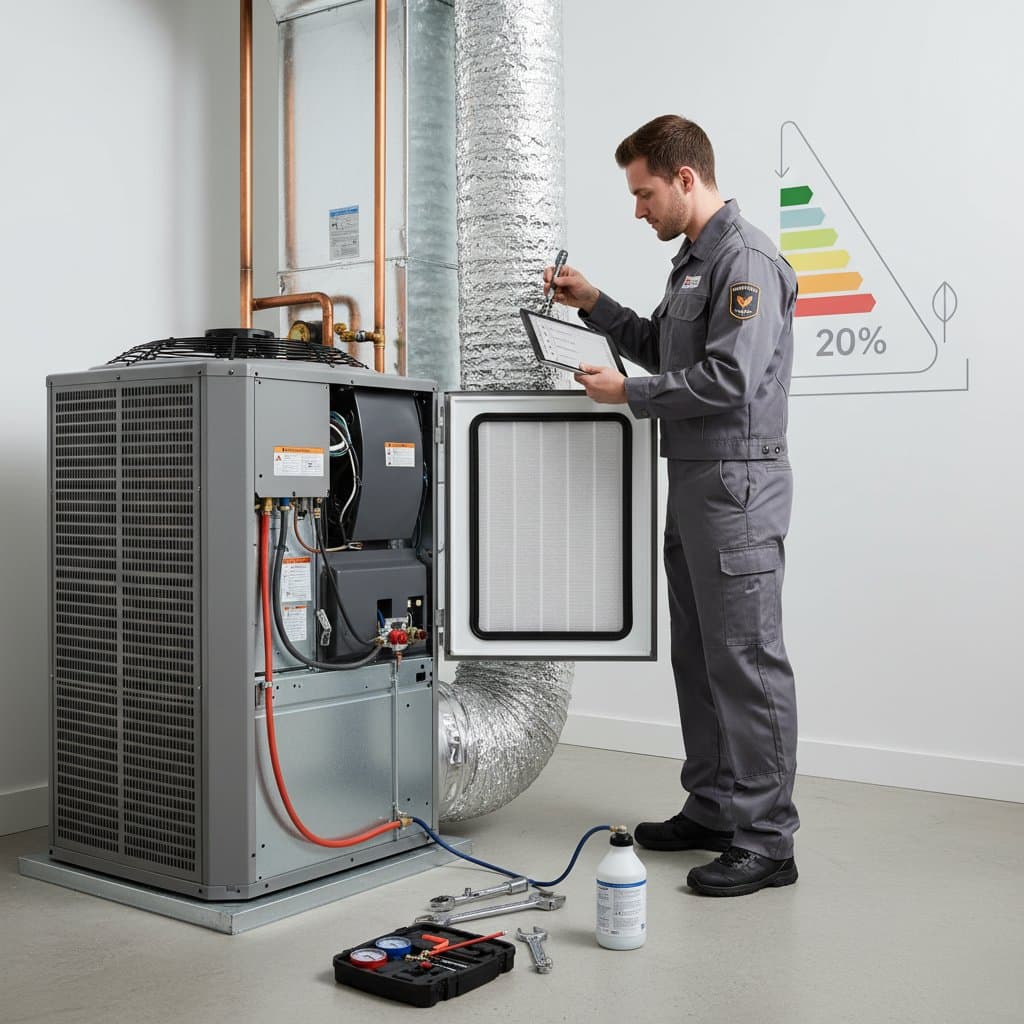Key Tasks for Reliable Summer AC Performance
Summer heat and humidity transform a dependable air conditioner into the core of household comfort. Homeowners often overlook their cooling systems until failures occur, yet regular upkeep during warm weather averts expensive repairs and controls energy expenses. Effective air conditioning maintenance involves straightforward steps and a prioritized list of critical actions.
Core Principles of AC Efficiency
Air conditioning systems rely on unrestricted airflow, efficient heat transfer, and pristine components. Blockages or stress in these areas diminish output, leaving homes warmer despite nonstop operation. The steps below detail how to sustain these elements for optimal performance and consistent indoor comfort.
Clean or Replace Air Filters Monthly
Clogged filters rank as the primary reason for subpar cooling. Dust, pet dander, and pollen buildup restricts airflow, forcing the unit to labor excessively and accelerating compressor wear while elevating power consumption.
Examine filters monthly during peak usage. Hold the filter against light; replace or clean if visibility through it diminishes. Rinse reusable filters under water and allow full drying before reinstalling. Opt for disposable pleated filters of superior quality to capture more particles effectively.
Clear Debris from the Outdoor Condenser
The exterior condenser requires unobstructed space to dissipate heat. Accumulated leaves, grass clippings, or soil hinder this process, prompting short cycling and inconsistent indoor temperatures.
Survey the condenser area monthly. Maintain a two-foot clearance by trimming plants on all sides. Clear nests, weeds, or obstructing objects. Gently brush or vacuum fins to dislodge surface debris without damaging them. For stubborn accumulations or oily layers, engage a professional for thorough restoration.
Inspect and Maintain the Condensate Drain Line
Cooling removes humidity from indoor air, which exits via a drain line to the exterior or a floor drain. Blockages or bends in this line trap moisture, fostering mold or causing water damage.
Find the drain near the indoor air handler. Look for obstructions or pooled water. Flush the line with a cup of white vinegar every few months to inhibit algae. Shut off the unit and summon a technician if leakage appears near the equipment. Prompt intervention prevents major issues.
Verify Thermostat Accuracy and Settings
The thermostat dictates runtime and duration. Faulty readings or sensors lead to inefficiency and uneven comfort. Confirm the display matches actual room temperature; wipe it with a soft cloth and swap batteries if applicable.
Upgrade from manual to programmable or smart models for better control. Programmable units, when calibrated correctly, trim cooling expenses by about ten percent per season. Smart versions adapt to daily patterns for precise adjustments.
Seal Ducts to Enhance Air Distribution
Leaks in ductwork squander cooled air en route to living areas, extending runtime to achieve desired temperatures. During operation, run hands along visible ducts to detect escaping air. Apply foil tape or mastic sealant to minor fissures.
For significant leaks, professionals conduct pressure tests and use specialized materials. Ensure registers and vents remain free of furniture, drapes, or carpets. Even distribution minimizes compressor stress and stabilizes room temperatures.
Examine Electrical Connections
Frayed wires or loose terminals provoke erratic operation or shutdowns. Disconnect power before checking. Scan for scorch marks, damaged insulation, or heat signs. Secure accessible connections with a screwdriver, but call a licensed expert for any visible harm.
Annual professional reviews incorporate electrical diagnostics to verify safe voltage and amperage levels, safeguarding against failures.
Clean Evaporator and Condenser Coils Regularly
Filters alone cannot prevent all coil contamination from dust and debris. Soiled coils impair heat absorption and expulsion, prolonging cycles and raising energy demands.
Access the indoor evaporator coil panel and brush away loose dirt softly. Apply a no-rinse cleaner from supply stores. For the outdoor condenser, power down and hose fins inward with moderate pressure to straighten any bends. Seek expert deep cleaning if frost forms or buildup persists.
Assess Home Insulation and Sealing
Even a top-tier AC falters if cool air leaks through gaps or inadequate insulation. Inspect door and window frames, plus attic accesses, for drafts. Renew weatherstripping and fill voids with foam sealant. Bolster insulation in attics and crawlspaces as required.
A tightly sealed envelope lightens the AC load, enhancing longevity and efficiency.
Arrange Annual Professional Tune-Ups
DIY efforts complement but do not substitute expert service once yearly before summer. Technicians verify refrigerant charge, safety mechanisms, lubrication, and pressure balances. Maintenance agreements often provide scheduled visits and expedited repairs.
Such routines prolong equipment life by years and slash breakdown risks, delivering strong returns on investment.
Track Energy Consumption and System Output
Monitor bills and comfort daily. Spikes in usage or cooling shortfalls signal underlying problems. Log data via thermostat features or invoices to spot trends early.
Timely adjustments or interventions curb repair costs and sustain summer ease.
Prepare for Timely System Replacement
Units endure 10 to 15 years with care, but aging reduces effectiveness. Frequent fixes or patchy cooling indicate upgrade time. Newer designs feature variable-speed operation and eco-friendly refrigerants for reduced noise and consumption.
Consult contractors ahead of heat peaks to evaluate choices calmly.
Build Lasting Cooling Reliability
Sustained comfort arises from routine vigilance rather than sporadic efforts. Integrate filter cleaning, debris removal, and expert oversight with thermostat tweaks and sealing upgrades. These practices fortify against heat extremes, preserving efficiency and tranquility.





